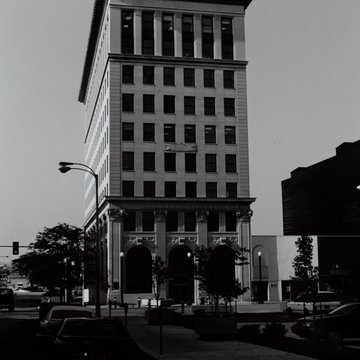You are here
First National Bank Building (now First Bank)
Both of the principals of this Chicago firm attended the Ecole des Beaux-Arts in Paris. Their nine-story Davenport Bank Building is a forceful testimony to their ability to carry on the classical tradition. Though they applied the usual design principle of base, shaft, and capital to the two street facades, they refined the building's finely cut limestone surfaces so that the plain walls dominate, and they laid on the usual classical detailing in a light, linear manner. On the recessed surfaces around the main entrance are eight panels of standing figures in relief. The entrance and lobby were “influenced by the Italian Renaissance and by the metal compositions in the Rejas of the Spanish Renaissance.” 17 The ground-floor windows which light the main public banking room were divided into a horizontal window grouping below, then a paneled soffit, and finally an upper lunette window, with all of this detailing carried out in metal.
Notes
“The First National Bank Building, Davenport, Iowa, Childs and Smith,” Architecture 51:4 (April 1925): 125–26.
Writing Credits
If SAH Archipedia has been useful to you, please consider supporting it.
SAH Archipedia tells the story of the United States through its buildings, landscapes, and cities. This freely available resource empowers the public with authoritative knowledge that deepens their understanding and appreciation of the built environment. But the Society of Architectural Historians, which created SAH Archipedia with University of Virginia Press, needs your support to maintain the high-caliber research, writing, photography, cartography, editing, design, and programming that make SAH Archipedia a trusted online resource available to all who value the history of place, heritage tourism, and learning.














